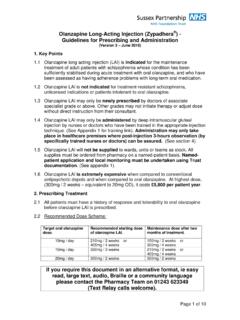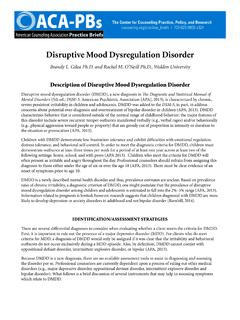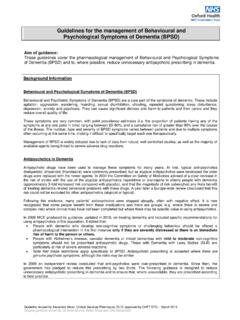Transcription of Guidance on the Use of Antidepressants in Children and ...
1 Guidance on the Use of Antidepressants in Children and Adolescents (Version 2 January 2014) If you require this document in an alternative format, ie easy read, large text, audio, Braille or a community language please contact the Pharmacy Team on 01243 623349 (Text Relay calls welcome) GUIDELINE NO RATIFYING COMMITTEE DRUGS AND THERAPEUTICS GROUP DATE RATIFIED January 2014 DATE AVAILABLE ON INTRANET NEXT REVIEW DATE January 2016 POLICY AUTHORS Graham Brown (Lead Pharmacist) James Atkinson (Pharmacist Team Leader) Paula Jenkins (Consultant Psychiatrist) Jed Hewitt (Chief Pharmacist) 2 Contents 1.
2 MANAGEMENT OF DEPRESSION 3 Introduction & Summary 3 Choice of Antidepressant 5 Indications for initiating an Antidepressant 6 Antidepressants & Suicidality 6 Monitoring 6 Duration of treatment 7 Age specific Response to Antidepressants 7 Further treatment Options
3 7 Electroconvulsive Therapy 8 2. MANAGEMENT OF ANXIETY disorders 8 3. SUGGESTED DOSING OF Antidepressants 9 Fluoxetine 9 Citalopram 9 Escitalopram 9 Sertraline
4 9 Mirtazapine 4. REFERENCES 10 31. MANAGEMENT OF DEPRESSION Introduction & Summary Antidepressants are used for a variety of presentations in Children and adolescents, however few Antidepressants are licensed for use in childhood disorders and the evidence base is poor. Prescribers must remain aware that recommendations for the use of medication other than fluoxetine are based on paper review and subsequent interpretation is not supported by the Medicines and Healthcare Products Regulatory Agency (MHRA).
5 The CSM in June, September and December 2003 issued advice stating: Only fluoxetine has been shown in clinical trials to be effective in treating depressive illness in Children and adolescents, although it is possible that, in common with the other SSRIs, it is associated with a small increased risk of self-harm and suicidal thoughts. Overall, the balance of risks and benefits for fluoxetine in the treatment of depressive illness in under-18s is judged to be favourable 1 Therefore, prescribing beyond fluoxetine places the prescriber at greater risk with regard to accountability and liability for treatment outcome.
6 However it is recognised that specialists may sometimes decide to use other Antidepressants in response to individual clinical need. It is therefore strongly recommended that if prescribers are considering the use of medication beyond fluoxetine, sertraline or citalopram (the latter two being off-licence but with a reasonable evidence base), they seek a second opinion from a consultant/associate specialist colleague2, 3 and/or input from the specialist CAMHS pharmacist before proceeding. The use of an antidepressant beyond those previously highlighted requires appropriate written consent.
7 Antidepressants should only be used in moderate to severe depression4,5 & 6. Psychological therapies should be the cornerstone of treatment with the use of Antidepressants being restricted to use after psychological therapies are initiated unless such therapies are refused. If psychological therapy is trialled and proves insufficient in the resolution of depressive symptoms then consideration may be given to initiation of antidepressant medication. Information leaflets for antidepressant medication are available in both a young person (easy read) and adult format. These can be accessed at The Trust advises the use of consent forms, particularly when the antidepressant is off licence.
8 These can be accessed at: Use in Children and adolescents under 18 years of age: Suicide-related behaviours (suicide attempt and suicidal thoughts) and hostility (predominantly aggression, oppositional behaviour and anger) were more frequently observed in clinical trials among Children and adolescents treated with Antidepressants compared to those treated with placebo. NICE CG28 guidance4 suggests weekly contact with the child or young person and their parent(s) or carer(s) for the first 4 weeks of treatment . Choice of antidepressant Fluoxetine should be the first antidepressant considered for prescribing in Children and adolescents due to this antidepressant having the best evidence base available, whilst being licensed in those aged 8 years and over (4,5).
9 If a second line pharmacological therapy after fluoxetine is required then sertraline or citalopram are recommended2,3. These should only normally be used when the following criteria have been met: The patient and their parent(s)/carer(s) have been provided with appropriate written information regarding rational for treatment , benefits and risks, delay in onset of effect, time course of treatment , possible side-effects, and the need for adherence to the treatment regime. Provision of the latest patient information is available from 4 and any advice from the MHRA subsequent to this publication should also be considered.
10 The depression is sufficiently severe and/or causing sufficiently serious symptoms to justify the trial of another antidepressant. There is clear documented evidence of a fair trial of fluoxetine in combination with psychological therapy. There has been a reassessment of the likely causes of the depression, of any possible treatment resistance and other potential diagnosis bipolar disorder or substance misuse. The initiating prescriber is a consultant or associate specialist child and adolescent psychiatrist. The child/young person and/or someone with parental responsibility (where appropriate) has signed an appropriate consent to treatment form.










